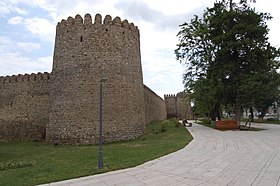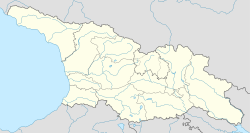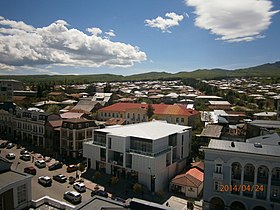Telavi
Telavi
თელავი | |
|---|---|
Town | |
   | |
 Flag  Coat of arms | |
 Telavi Location of Telavi in Georgia | |
| Coordinates: 41°55′0″N 45°29′0″E / 41.91667°N 45.48333°ECoordinates: 41°55′0″N 45°29′0″E / 41.91667°N 45.48333°E | |
| Country | Georgia |
| Mkhare | Kakheti |
| Municipality | Telavi Municipality |
| Elevation | 490 m (1,610 ft) |
| Population (2020) | |
| • Total | 19,599 |
| Time zone | UTC+4 (Georgian Time) |
| Area code(s) | (+995) 350 |
| Website | telavi |
Telavi (Georgian: თელავი [tʰɛlɑvi]) is the main city and administrative center of Georgia's eastern province of Kakheti. Its population consists of some 19,629 inhabitants (as of the year 2014).[1] The city is located on the foothills of the Tsiv-Gombori Range at 500–800 m (1,600–2,600 ft) above sea level.
History[]
The first archaeological findings from Telavi date back to the Bronze Age. One of the earliest surviving accounts of Telavi is from the 2nd century AD, by Greek geographer Claudius Ptolemaeus, who mentions the name Teleda (a reference to Telavi). Telavi began to transform into a fairly important and large political and administrative center in the 8th century. Interesting information on Telavi is provided in the records by an Arab geographer, Al-Muqaddasi of the 10th century, who mentions Telavi along with such important cities of that time's Caucasus as Tbilisi, Shamkhor, Ganja, Shemakha and Shirvan. Speaking about the population of Telavi, Al-Muqaddasi points out that for the most part it consisted of Christians.

From the 10th until the 12th century, Telavi served as the capital of the Kingdom of Kakheti and later . During the so-called Golden Era of the Georgian State (12th–13th centuries), Telavi turned into one of the most important political and economic centers of the Georgian State. After the disintegration of the united Georgian Kingdom in the 15th century, the role of Telavi started to decline and the city eventually became an ordinary town of trade and crafts. Telavi regained its political importance in the 17th century when it became a capital of the kingdom of Kakheti. By 1762, it turned into the second capital (after Tbilisi) of the united Eastern Georgian Kingdom of Kartl-Kakheti. The reign of King Erekle II, who was born and died in this city, was a special epoch in the history of Telavi. During this period (1744–1798) it grew into a strategic and cultural centre. Erakle II established there a theological seminary and founded a theatre. Erekle II's reforms touched upon all aspects of life in the country. They changed fundamentally the political, economical and cultural orientation of Kartli-Kakheti and, subsequently of the whole Georgia. His name became a symbol of freedom and national independence of the Georgian people. Erakle II is still called affectionately "Patara Kakhi" (Little Kakhetian), and his heroic deeds are described in folk literature.
Russian rule[]

In 1801, after the Kingdom of Kartli-Kakheti was annexed by the Russian Empire, Telavi lost its status as a capital. In the 19th century, the city was given the status of an administrative center of an uyezd within the Tiflis Governorate. During that period, the economy of the city was mainly composed of small-scale industries (leather painting, pottery production, wine-making, etc.), commerce and agriculture. The town's population was about 12,000 in the end of the 19th century (including about 9,000 Armenians and 2,000 ethnic Georgians).[2]
Heritage[]
Telavi and its surroundings are rich in historical, architectural and natural monuments. The most important heritage monuments preserved within the city limits include:
- Dzveli Galavani ("Old Walls") - fortress of the first Kakhetian kings (9th–10th centuries)
- Church of the St. Mary (16th century)
- Church of the Holy Trinity (6th century)
- Fortress Batonis Tsikhe ("Fortress of Master") built in the 17th century; one of the only well-preserved medieval royal palaces in Georgia
- Korchibashishvilebis Tsikhe - castle of the local noblemen named Korchibashishvilis (16th–18th century)
- akhvakhishvilebis Tsikhe - castle of the local noblemen named Vakhvakhishvilis (18th century)

Telavi is the only city in Georgia where four fortification monuments from four historical periods remain relatively intact. Due to this reason, architects, scholars and art historians consider Telavi as the most "medieval" city in the country. Another curious sight in Telavi is a 900-year-old plane tree which is 40 m (130 ft) high and 11 m (36 ft) around the trunk.[3] Other notable landmarks around Telavi include the Alaverdi Cathedral (11th century), the second highest cathedral in Georgia after the newly built Tbilisi Sameba Cathedral; the Ikalto Academy (8th-12th centuries–), where the famous Georgian writer Shota Rustaveli studied; the Church of St. George (dedicated to the patron saint of Georgia, where it is said that there are 365 churches named St. George); ruins of the city and castle of Gremi (the former capital of Kakheti during the 15th–17th centuries); , a complex made of three churches of different periods—6th, 7th and 8th centuries—in a highland forest; ("New Shuamta" in English), the monastery close to Dzveli Shuamta ("Old Shuamta" in English), built in the 16th century; the stunning (the residential Palace of Noblemen Chavchavadzes family); and many others.
Geography[]

Telavi faces the Tsiv-Gombori Range to the south and southwest and borders on the Alazani Valley to the north and east.
The Greater Caucasus Mountain Range, which runs to the north of the Alazani Valley, can be seen from most of Telavi.
At present, the city of Telavi is connected with Tbilisi by two highways. The most widely traveled (and better-paved) highway runs through the rural areas of Kakheti and is longer (the overall length of the highway is approximately 156 km (97 mi)) than the route, which runs through the highlands of the Gombori Mountain Range.
The shorter route (approximately 96 km (60 mi)) is quite scenic, but is less used due to the reconstruction works that are being carried out there from 2014, but now it is used way, it is little difficult for non professional and non experienced drivers, road is too much narrow and dangerous.
Because of its beauty, historical monuments and hospitality and the reputation for kindness of its residents, the city is a popular tourist destination in Georgia.
Climate[]
| Climate data for Telavi (1981–2010) | |||||||||||||
|---|---|---|---|---|---|---|---|---|---|---|---|---|---|
| Month | Jan | Feb | Mar | Apr | May | Jun | Jul | Aug | Sep | Oct | Nov | Dec | Year |
| Record high °C (°F) | 18.8 (65.8) |
19.4 (66.9) |
26.1 (79.0) |
32.3 (90.1) |
32.1 (89.8) |
34.7 (94.5) |
40.2 (104.4) |
39.4 (102.9) |
36.0 (96.8) |
32.7 (90.9) |
24.2 (75.6) |
21.3 (70.3) |
40.2 (104.4) |
| Average high °C (°F) | 6.2 (43.2) |
7.3 (45.1) |
11.7 (53.1) |
17.8 (64.0) |
22.1 (71.8) |
26.7 (80.1) |
29.6 (85.3) |
29.4 (84.9) |
25.0 (77.0) |
18.7 (65.7) |
12.2 (54.0) |
7.7 (45.9) |
17.9 (64.2) |
| Daily mean °C (°F) | 1.6 (34.9) |
2.5 (36.5) |
6.5 (43.7) |
12.1 (53.8) |
16.3 (61.3) |
20.7 (69.3) |
23.6 (74.5) |
23.2 (73.8) |
18.9 (66.0) |
13.2 (55.8) |
7.4 (45.3) |
3.2 (37.8) |
12.5 (54.5) |
| Average low °C (°F) | −1.8 (28.8) |
−1.2 (29.8) |
2.5 (36.5) |
7.7 (45.9) |
11.7 (53.1) |
15.7 (60.3) |
18.7 (65.7) |
18.3 (64.9) |
14.2 (57.6) |
9.4 (48.9) |
3.8 (38.8) |
−0.1 (31.8) |
8.3 (46.9) |
| Record low °C (°F) | −12.4 (9.7) |
−13.8 (7.2) |
−10.5 (13.1) |
−4.7 (23.5) |
3.1 (37.6) |
8.4 (47.1) |
11.0 (51.8) |
9.0 (48.2) |
4.5 (40.1) |
−1.6 (29.1) |
−6.3 (20.7) |
−13.7 (7.3) |
−13.8 (7.2) |
| Average precipitation mm (inches) | 23.1 (0.91) |
33.2 (1.31) |
51.1 (2.01) |
87.2 (3.43) |
118.1 (4.65) |
103.6 (4.08) |
67.7 (2.67) |
76.2 (3.00) |
63.8 (2.51) |
67.0 (2.64) |
49.4 (1.94) |
30.3 (1.19) |
767.6 (30.22) |
| Source: World Meteorological Organization[4] | |||||||||||||
Politics[]

Telavi Municipal Assembly (Georgian: თელავის საკრებულო) is a representative body in Telavi. currently consisting of 33 members. The council is assembles into session regularly, to consider subject matters such as code changes, utilities, taxes, city budget, oversight of city government and more. Telavi sakrebulo is elected every four year. The last election was held in October 2017. [5]
| Party | Seats | Current Municipal Assembly | |||||||||||||||||||||||||||
|---|---|---|---|---|---|---|---|---|---|---|---|---|---|---|---|---|---|---|---|---|---|---|---|---|---|---|---|---|---|
| Georgian Dream | 24 | ||||||||||||||||||||||||||||
| UNM | 5 | ||||||||||||||||||||||||||||
| European Georgia | 2 | ||||||||||||||||||||||||||||
| For Georgia | 1 | ||||||||||||||||||||||||||||
| Alliance of Patriots | 1 | ||||||||||||||||||||||||||||
Notable Residents[]
- King Erekle II (1720-1798), King of Kartli and Kakheti
- King George XII (1746-1800), Last Georgian Monarch
- Prince Iulon (1760-1816), Georgian prince, half-brother of King George XII
- Elene Akhvlediani (1898-1976), Georgian painter
- Girgor Harutyunyan (1900-1957), First Secretary of the Communist Party of the Armenian SSR
- Henrik Malyan (1925-1988), Armenian film director
- Givi Chikvanaia (1939-2018), Georgian waterpolo player
- Kakhi Asatiani (1947-2002), Georgian football player
- Larissa Petrosyan (1993-), model
- Givi Chokheli (1937-1994), Georgian football player
In popular culture[]
Telavi serves as the hometown of the Georgian bush pilot Mimino (Vakhtang Kikabidze) in the 1977 Soviet comedy Mimino.
Gallery of Telavi[]
See also[]
References[]
- ^ "2014 General Population Census Main Results General Information" (PDF). geostat.ge. National Statistics Office of Georgia. Retrieved 16 July 2017.
- ^ "Телав" [Telav]. Энциклопедия Брокгауза и Ефрона (Brockhaus and Efron Encyclopedic Dictionary) (in Georgian).
- ^ "900 Year Old Plane Tree to Be Rehabilitated". Georgia Today. Retrieved 16 July 2017.
- ^ "World Meteorological Organization Climate Normals for 1981–2010". World Meteorological Organization. Archived from the original on 9 October 2021. Retrieved 9 October 2021.
- ^ https://cesko.ge/res/docs/danOK47.pdf
- Rosen, Roger. Georgia: A Sovereign Country of the Caucasus. Odyssey Publications: king Kong, 1999. ISBN 962-217-748-4
External links[]
| Wikimedia Commons has media related to Telavi. |
- Kakheti.net tourism site
- . Encyclopædia Britannica (11th ed.). 1911.
- Cities and towns in Kakheti
- Tiflis Governorate
- Self-governing cities in Georgia (country)
- Bronze Age in Georgia










